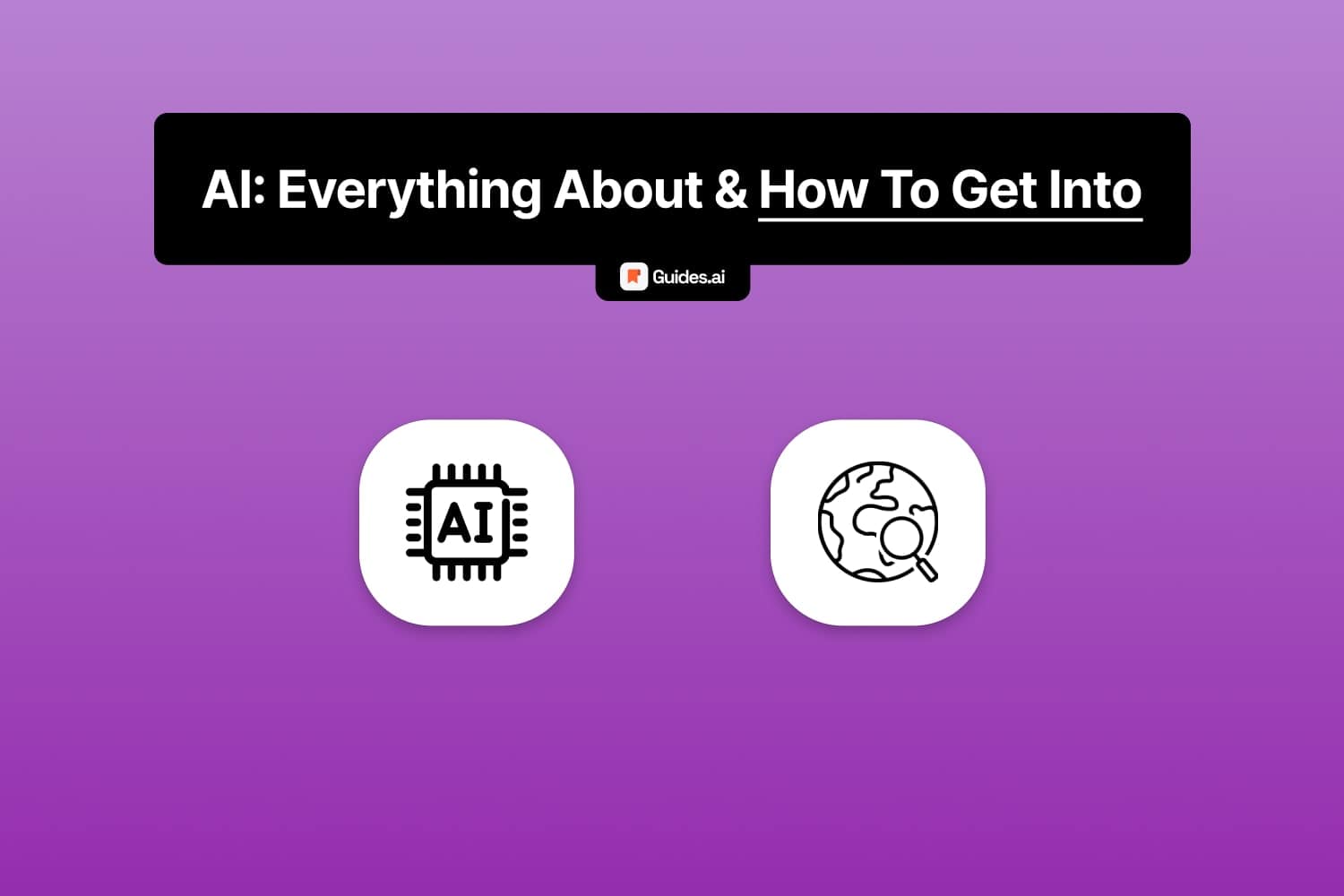You’re most likely here because you want to learn:
- How to get into AI – Artificial Intelligence
- But you have no idea where to begin
- And all other guides are: too long, hard to read, and say same thing
I’ve been in your position — and I’ve been through all these boring guides.
The search stops here.
Read below this paragraph and you’ll become a pro in AI and ML.
Contents






How to become an AI expert
Start by understanding the AI fundamentals, then dive deep into various apps and how to put them into practice.
Then, scale your AI efforts the smart way. Stay ahead with the latest trends, and continuously upskill.
Essentially: Before using ChatGPT, you need to understand what it is and how it works.
Below is my complete breakdown.
Join me!
Chapter I: Fundamentals
This section focuses on: What is AI.
1. Definition
- AI (Artificial Intelligence) aims to create machines that can perform tasks requiring human-like intelligence.
- ML (Machine learning) is like teaching computers to spot patterns and make decisions based on data without being explicitly programmed for those tasks.
AI: Includes learning, decision-making, and problem-solving.
ML: Giving computers the ability to learn from examples. Just like how you might learn to recognize a cat by looking at lots.
2. Background skills
Don’t worry, you don’t have to be an expert in these.
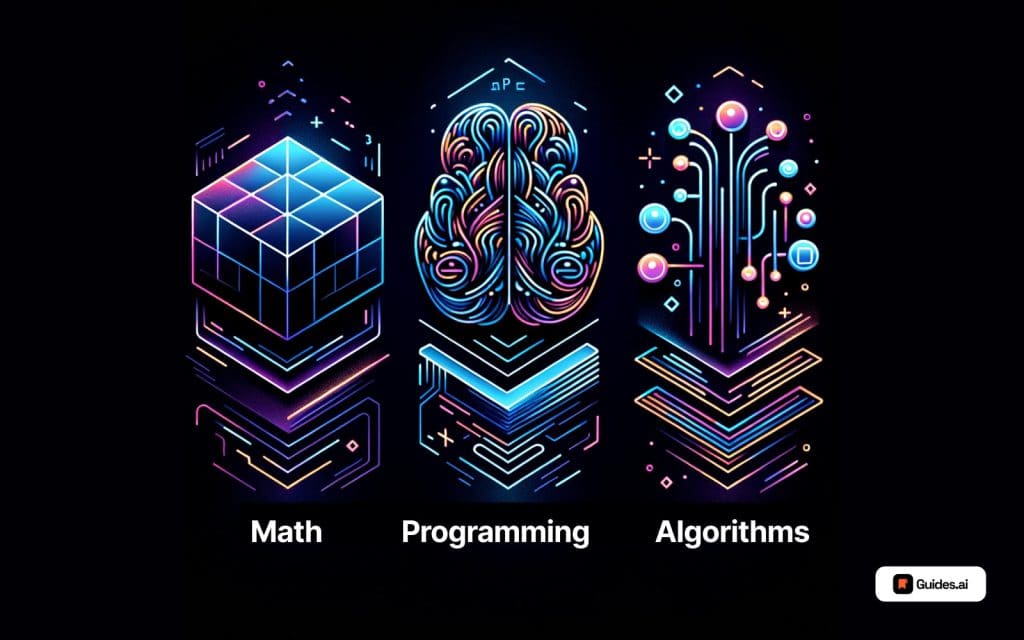
Math
- Calculus: Concepts like derivatives and integrals are foundational.
- Linear Algebra: Know your way around matrices, vectors, and eigenvalues.
- Probability and Statistics: Learn distributions, mean, median, etc.
Programming
- Python: Master Python syntax and commonly used libraries.
- TensorFlow/PyTorch: Pick at least one machine learning framework to learn.
Algorithmic
- Understand basic algorithms and data structures: arrays, linked lists, trees, and graphs.
Don’t be scared, though — you don’t need to know deep math to use AI.
You’ll only need it if you plan on going super deep into building AI tools and whatnot.
3. How to study AI
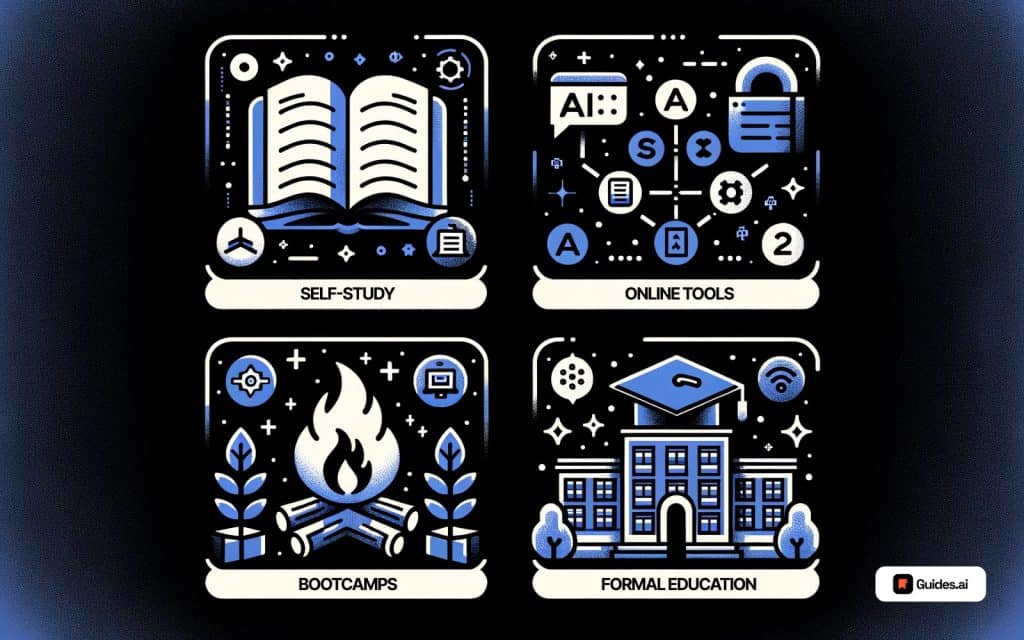
Self-Study
- Utilize online courses, tutorials, and research papers. Coursera, Udacity, and edX are platforms to consider.
Bootcamps
- These are intensive, short-term programs focused on practical skills.
Formal Education
- Degrees in Computer Science, Data Science or AI provide a structured environment and networking opportunities.
- Obviously, this will take too long.
That’s why you’re better of with courses.
I’ve got a list for the 10 best AI courses.
4. How AI works
These details sit at the base of Artificial Intelligence.
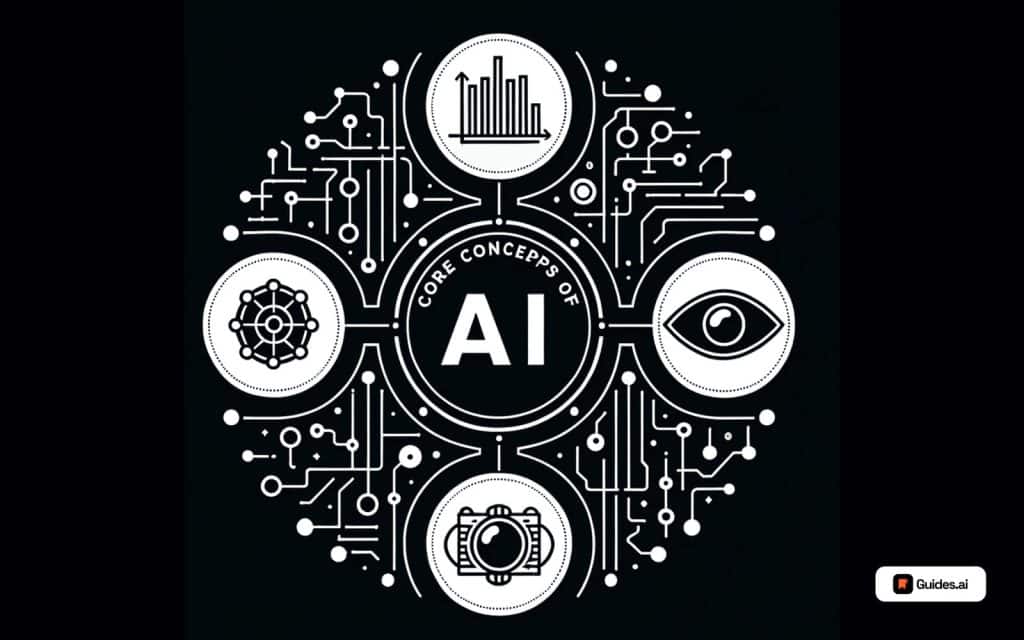
Machine Learning Types
- Supervised Learning: Works with labeled data. Examples include regression and classification.
- Unsupervised Learning: Focuses on unlabeled data. Examples include clustering and association.
- Reinforcement Learning: The model learns by interacting with an environment to achieve a goal or objective.
Neural Networks
- Understand the architecture: input layer, hidden layers, and output layer.
NLP: Natural Language Processing
- Techniques to understand and generate human language. Covers text analysis, language models, and translation.
Computer Vision
- Algorithms for image and video recognition, including object detection and segmentation.
5. Practical skills
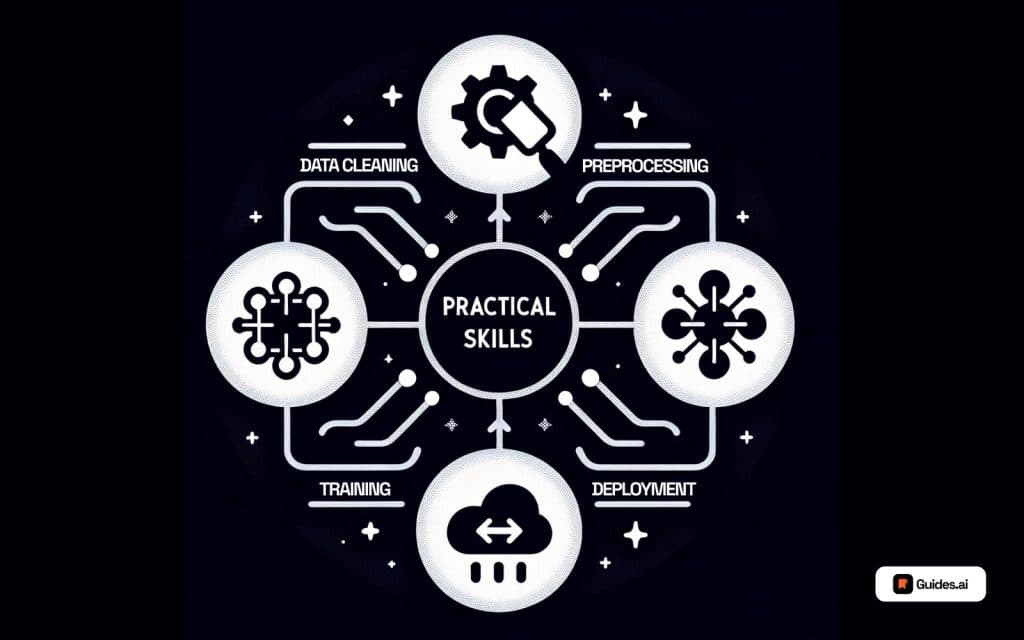
Data Cleaning and Preprocessing
- Techniques for handling missing data, normalization, and encoding.
Model Training and Evaluation
- Understand metrics like accuracy, precision, recall, and F1 score.
Deployment
- Learn how to deploy your model into a production environment, using technologies like Docker and cloud services.
6. Build a portfolio

GitHub
- Keep your code and projects on GitHub to showcase your skills.
Competitions
- Participate in Kaggle competitions to test and improve your skills.
Open Source Contributions
- Contribute to open-source projects related to AI.
7. Networking
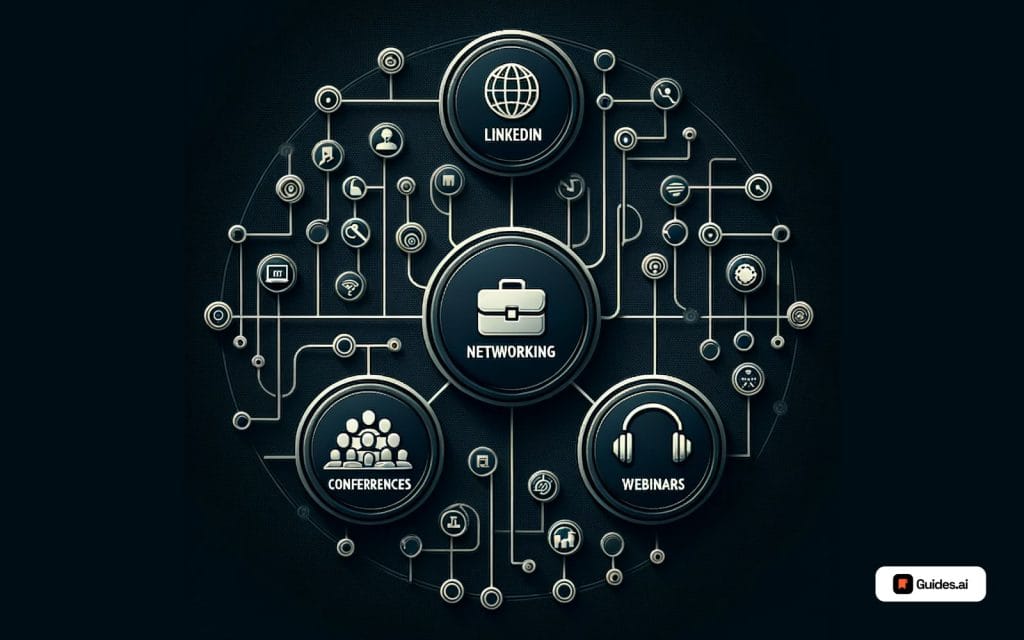
- Use LinkedIn to connect with industry professionals and to look for job opportunities.
Conferences and Webinars
- Attend to stay updated and to network with others in the field.
Communities
- Reddit, Indie Hackers, and various Twitter communities may be of help.
Furthermore, even Hacker News is a great place.
8. Job opportunities
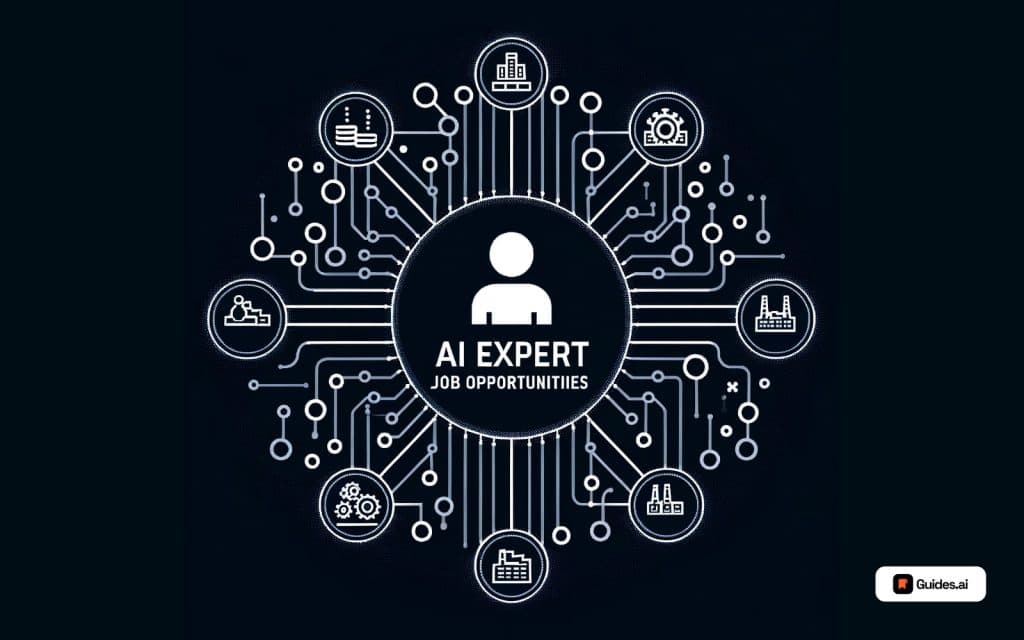
Roles
- Machine Learning Engineer, Data Scientist, AI Research Scientist, etc.
Industries
- AI has applications in healthcare, finance, automotive, retail, and more.
Finance
- Algorithmic trading, fraud detection, and customer service, leading to job openings for data analysts, machine learning specialists, and financial advisors.
Content making
- AI-driven tools can generate articles, blog posts, and social media content, reducing the need for manual content creation
Start making AI content with the most powerful AI Generation Tools.
Chapter II: How to use AI
In this section, I’ll speak about understanding the basics when actually starting to use AI.
This section focuses on: How to get get going with AI
1. Identifying needs

Objectives
- Operational Efficiency: If your aim is to streamline operations, look for AI tools geared towards automation.
- Business Insights: If decision-making is your focus, analytics tools might be your go-to.
Scope
- Focused Approach: Target a specific pain point, like customer support, and deploy a tailored AI solution like a chatbot.
- Holistic Approach: Integrate AI across different business operations for an overarching impact.
Budget
- Financial Budget: Determine the cost of implementing AI.
- Human Resources: Do you have staff skilled in AI or will you need to hire or outsource?
2. Choosing tools

Pre-built solutions
- For simple tasks, existing AI software like chatbots or recommendation engines can suffice.
Custom solutions
- For specific needs, custom-built models are the way to go.
3. Getting started
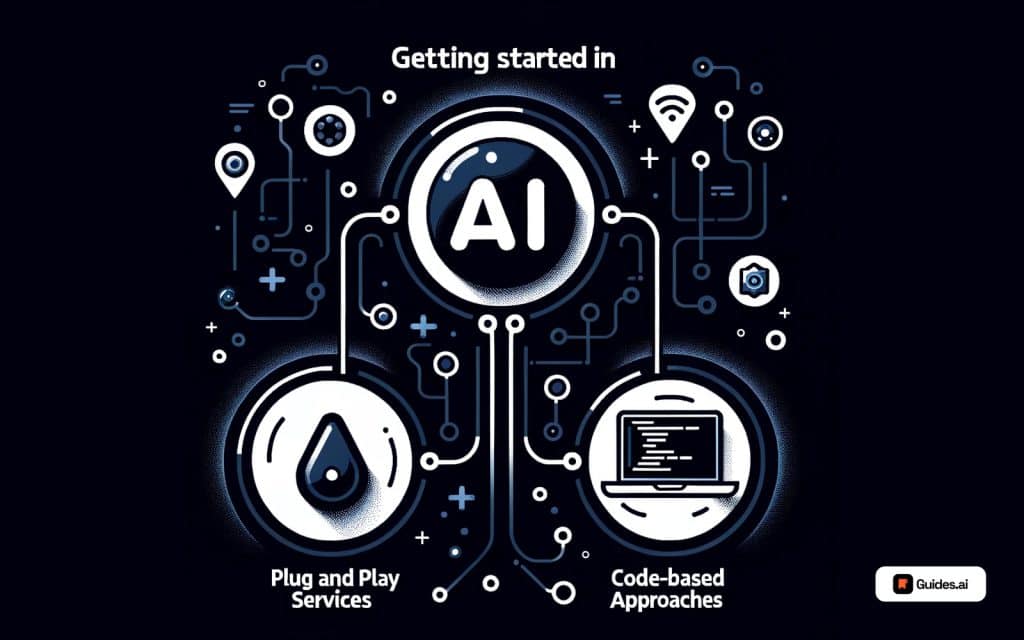
Plug-and-Play Services
- Platforms like Google’s AutoML offer easy-to-use AI solutions.
Code-Based Approaches
- Use Python libraries like TensorFlow or PyTorch for more control over your AI model.
API
- Looking to build an AI-based app? You then need an AI-API Tool.
4. Data preparation
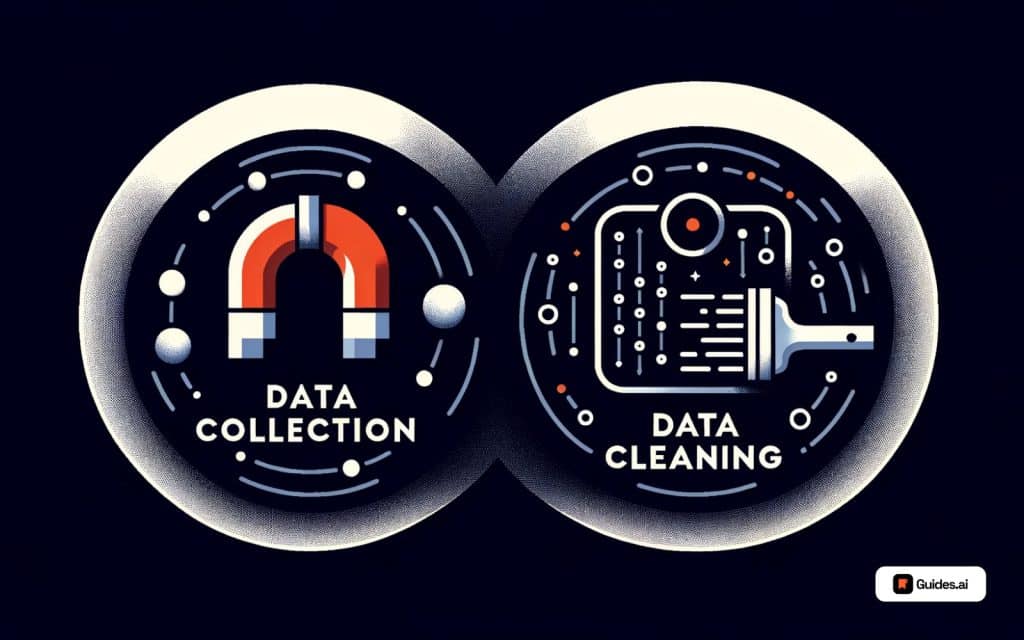
Collection
- Gather the data the AI you create will learn from.
Cleaning
- Remove or fix any inconsistencies or errors in your data.
5. Model training

Training Data
- Use a subset of your data to train your model.
Validation and Testing
- Use another subset to validate and test the model.
Not sure how to do it? Read the guide on how to train ChatGPT, for example.
6. Go live
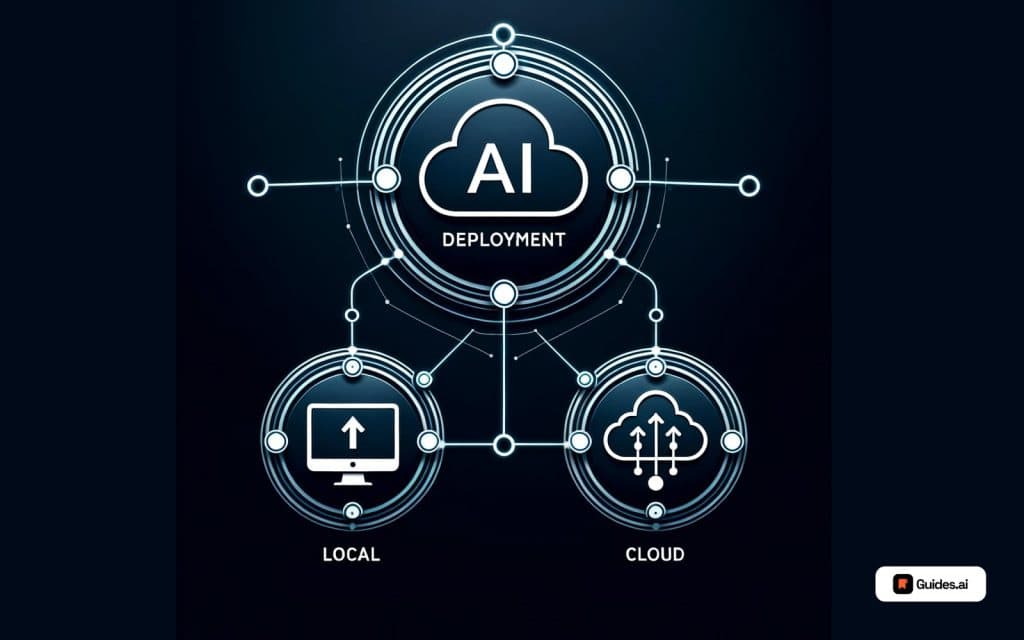
Local Deployment
- Run your model on a local machine for testing or limited use.
Cloud Deployment
- Use cloud services for scalable, high-availability models.
7. Maintenance
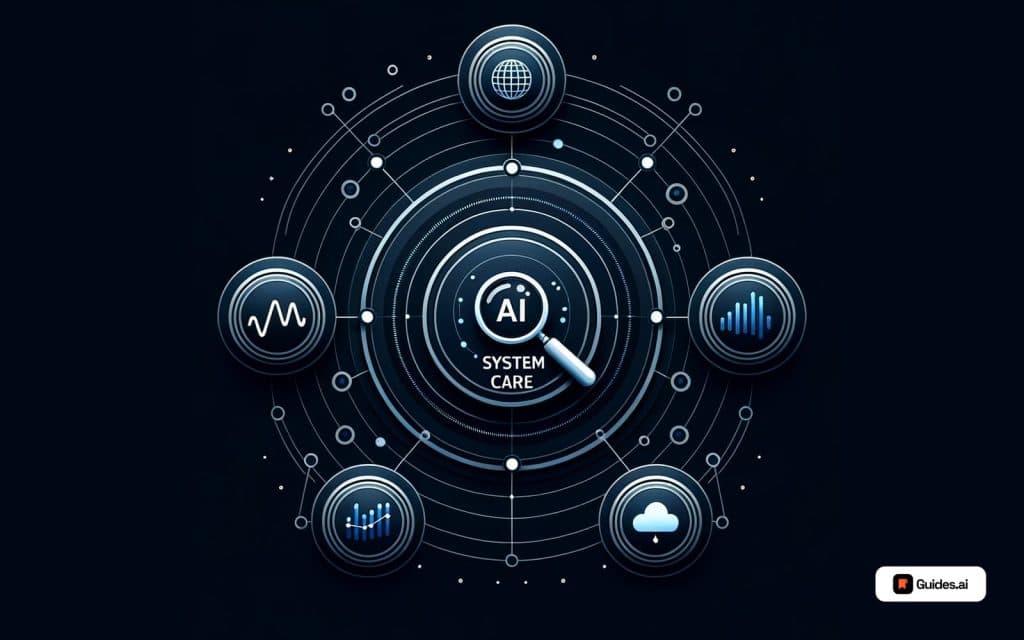
Performance metrics
- Keep an eye on how well your model is performing.
Updates
- Regularly update the model to adapt to new data.
8. Ethical concerns
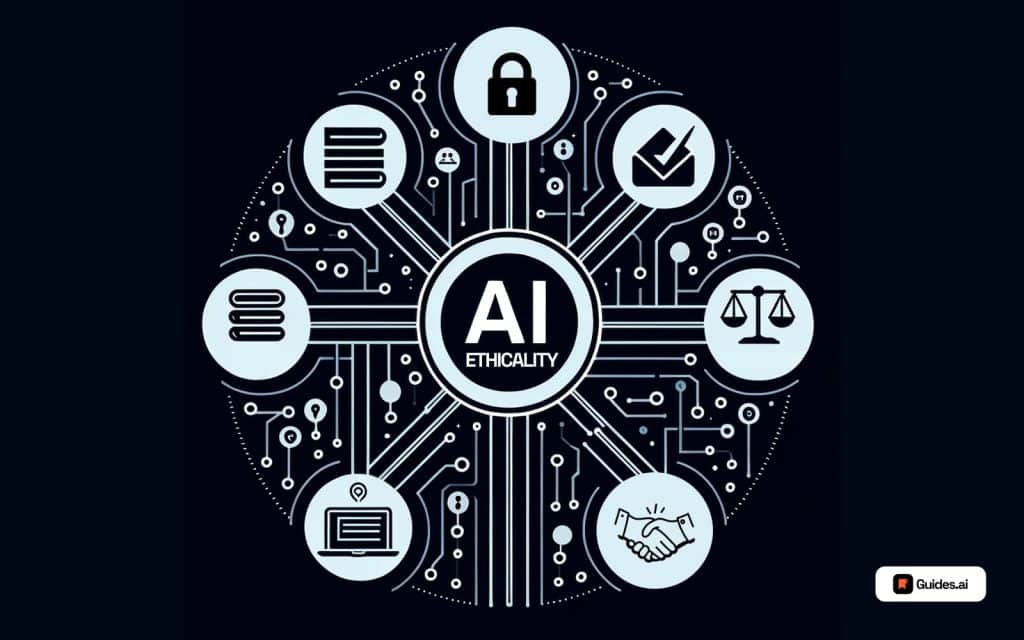
Data Privacy
- Make sure you have the right permissions for the data you use.
Fairness and Bias
- Check your model doesn’t reinforce existing stereotypes or biases.
Chapter III: The 6 AI Key-Principles
This section emphasizes on: The 6 must-know AI principles.
Before you go into the real world and use AI…
I need to make sure you’ve got the most important part.
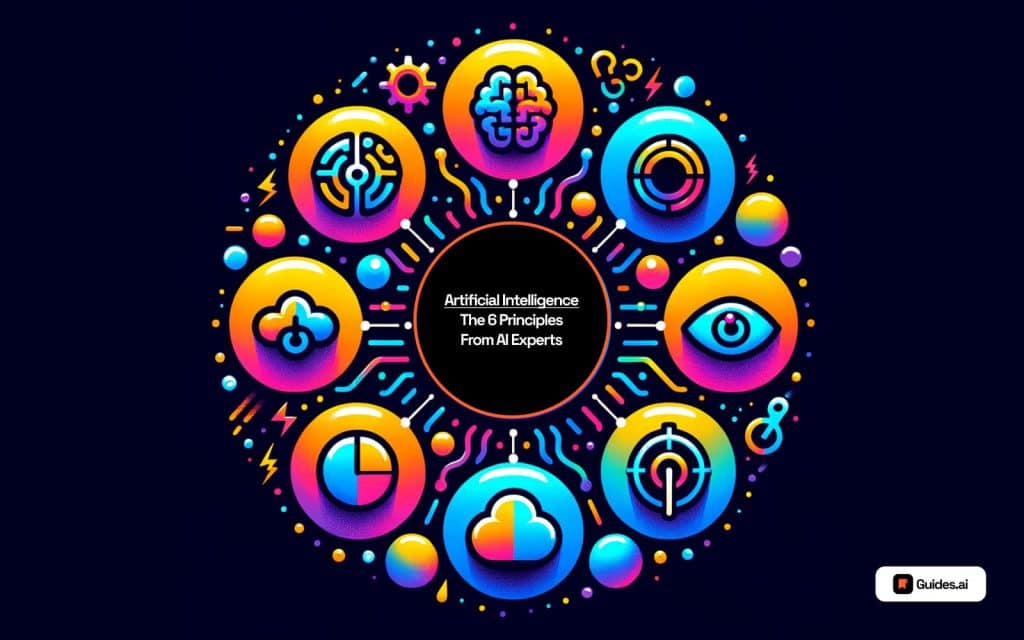
Below is my in-depth analysis + explanation.
1. Algorithms
These are the brains behind Artificial Intelligence.
- Supervised Learning: Great for tasks where the answer is known, such as email filtering.
- Unsupervised Learning: Useful when you’re exploring data, like customer segmentation.
- Reinforcement Learning: Ideal for decision-making processes, such as robotics.
2. Data
Data is the fuel for AI.
- Structured Data: Think databases, where everything is categorized neatly.
- Unstructured Data: This is your texts, images, and videos.
- Real-Time Data: Crucial for applications requiring immediate decision-making, like autonomous vehicles.
3. Computational Power
- CPUs: Suitable for basic tasks but can be slower for complex models.
- GPUs: A must-have for heavy lifting like deep learning.
- Cloud Computing: Offers scalability, letting you pay as you go.
4. Interpretability
- Feature Importance: Know what variables are most influential in your model.
- Explainable AI: Tools and models that allow you to understand how decisions are made.
- Bias Detection: Spot and correct any biased decisions made by the model.
5. Evaluation & Metrics
- Accuracy: Measures the ratio of correct predictions to total predictions. But be cautious; it’s not always the best metric.
- Precision and Recall: Useful for imbalanced datasets. Precision focuses on false positives, while recall focuses on false negatives.
- AUC-ROC Curve: Helpful for classification problems; it shows the trade-off between sensitivity and specificity.
6. OpenAI and ChatGPT
- ChatGPT is: A conversational model that excels in generating human-like text, ideal for customer service bots, virtual assistants, and more.
- Fine-Tuning: OpenAI offers ways to fine-tune ChatGPT to meet specific requirements, enhancing its utility.
- API Integration: With the OpenAI API, you can easily integrate ChatGPT into apps, websites, or other services.
- Ethical Use: OpenAI provides guidelines on responsible use, emphasizing data privacy and unbiased responses.
- Community and Updates: Staying updated with OpenAI’s research and community contributions can offer additional layers of mastery.
Relevant read: The 9 best AI-powered APIs
Chapter IV: Put AI Into Practice
This section is about: Integrating AI in your projects.
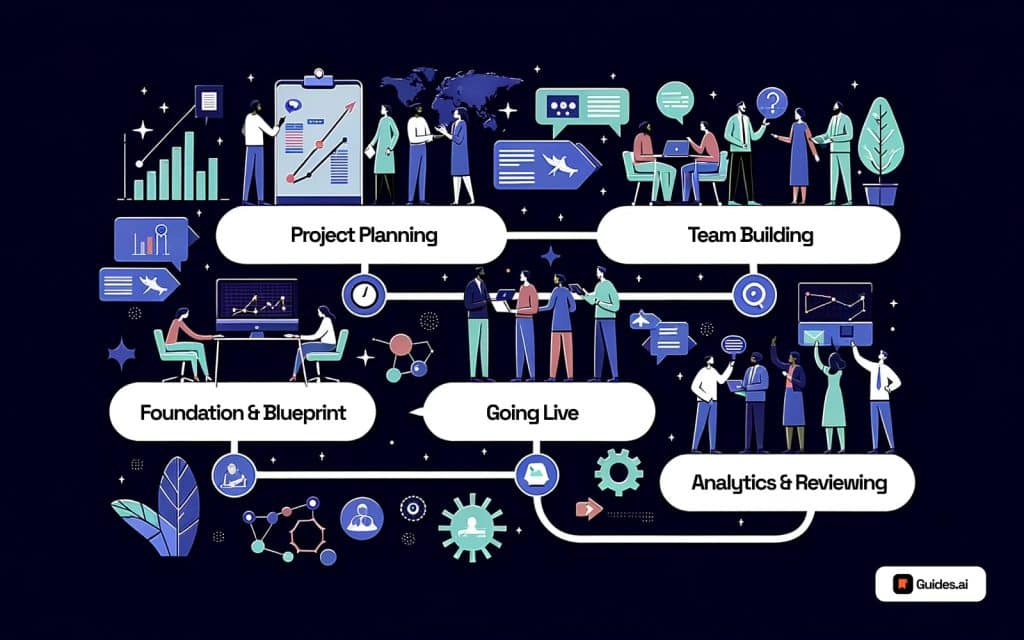
Now you know 100% about AI.
Let’s apply that knowledge in the real world.
1. Project planning
Set the stage first.
- Scope Definition: Clearly outline what you aim to achieve with AI.
- Milestones: Set key milestones for tracking progress.
- Risk Assessment: Identify potential challenges and how to mitigate them.
2. Team building
- Domain Experts: Include people who understand the industry you’re working in.
- Data Scientists: The core team who will build and fine-tune your models.
- Software Engineers: Those who’ll integrate the model into your existing systems.
3. Foundation
First, tools and infrastructure.
- Development Environment: Set up IDEs and repositories for code storage.
- Data Storage: Decide on databases and data lakes.
- Computational Resources: Secure necessary CPUs, GPUs, or cloud services.
4. Blueprint
- Model Selection: Choose initial models to test, based on your needs.
- Data Sampling: Use a small sample of data to validate the model’s concept.
- Feedback Loop: Create a mechanism for continuous feedback and model tweaking.
5. Integrate AI
- Integration Testing: Make sure the model interacts well with other system components.
- Deployment: Roll out the model, initially perhaps as a beta version.
- User Training: Educate the end-users on how to interact with the new AI features.
6. Analytics & Feedback
- Dashboard: Implement real-time tracking of key performance indicators (KPIs).
- Quality Assurance: Continuously validate the model’s output.
- Iterative Updates: Re-train the model as more data comes in or as objectives change.
7. Review your work
- Success Metrics: Did the project meet or exceed the predefined KPIs?
- Lessons Learned: What worked well, and what would you do differently?
- Future Planning: Identify new opportunities for further AI implementation.
Chapter V: Scale Your AI Efforts
This section is about: Making more with AI out of what you already have.
Happy or not with your results, there’s always room for improvement.
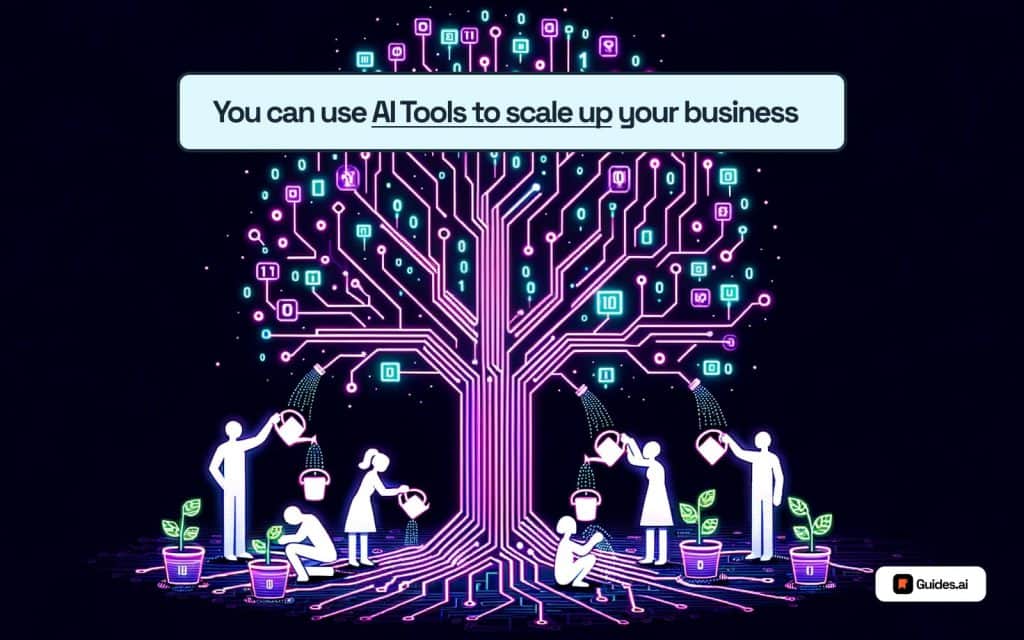
1. User adoption
More users, more data!
- Onboarding Plans: Craft easy-to-follow guides for new users.
- Feedback Channels: Collect user insights to understand adoption rates and bottlenecks.
2. Diversification
This is for more ways to use AI.
- New Use Cases: Identify additional tasks or decisions where AI could be beneficial.
- Feature Additions: Consider adding new features to your existing AI tools to make them more versatile.
3. Cost optimization
- Tiered Plans: If you’re using subscription services, adjust plans according to usage.
- Cost-Effectiveness Metrics: Continually assess the ROI of your AI implementations.
4. Service improvements
- Fine-Tuning: Make small adjustments to your AI services to improve performance.
- Speed and Responsiveness: Ensure your AI tools are as quick and agile as they need to be.
5. Data governance
- Privacy Policies: Make sure your AI usage complies with local and international data laws.
- Quality Assurance: Keep tabs on data quality and integrity, especially as you scale.
6. Skill building
- Training Modules: As AI evolves, so should your or your team’s understanding of it.
- Certifications: Obtain industry-recognized credentials for mastered AI platforms or methodologies.
7. Vendor management
- Service Level Agreements (SLAs): Revisit these to make sure vendors are meeting your scaled needs.
- Multi-Vendor Strategies: Don’t put all your eggs in one basket; diversify your AI sources.
8. Engage with people
- Forums and Groups: Engage in discussions to stay updated on the latest AI trends and best practices.
- Webinars and Events: These can offer new perspectives and deepen your understanding of AI applications.
Scaling your AI efforts is about optimizing across various fronts: cost, performance, and skills.
It’s not just about doing more, but doing better.
Chapter VI: Keep Up with Trends
This chapter gives you: Tools and resources to keep your finger on the pulse.
Staying updated is essential in the fast-paced world of AI.

From formal education to social media scrolling, every bit counts.
1. News
- Subscriptions: Sign up for newsletters from reputable AI sources.
- Example: MIT Technology Review.
2. Academic sorces
- Database Access: Utilize platforms like Google Scholar or JSTOR for the latest research.
- Example: Journal of Artificial Intelligence Research.
3. Social media
- Follow Influencers: Key people in the AI field often share valuable insights.
- Examples: Andrew Ng on Twitter, Yann LeCun on LinkedIn.
4. Conferences & Webinars
- Calendar Alerts: Set reminders for big annual events you don’t want to miss.
- Example: NeurIPS.
5. Courses
- Continued Learning: New methods and tools are always emerging. Stay current.
- Example: Coursera’s Machine Learning by Andrew Ng.
6. Podcasts & Videos
- Curated Lists: Create playlists of shows or channels that consistently deliver quality content.
- Examples: Two Minute Papers on YouTube.
7. Networking
- Communities and Groups: Join AI-focused groups on LinkedIn or specialized forums.
- Example: r/MachineLearning.
8. Case studies
- Corporate Insights: Companies often release whitepapers explaining how they solved problems using AI.
- Example: Google AI Blog.
9. Open-source projects
- Contribution: Taking part in these projects can give you practical experience and insights.
- Example: TensorFlow on GitHub.
Conclusion
I hope this guide helped you gain more knowledge on AI.
Learn how to become more productive with our guides on how to use AI.
Thank you for reading this,
Ch David and Daniel

